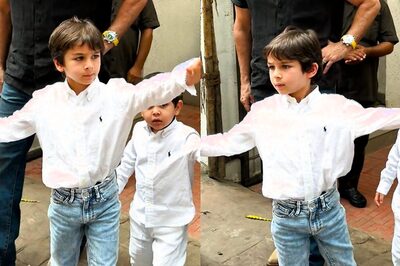
views
CHARLESTON, W.Va.: Fed up with poor wages, work and living conditions, thousands of coal miners a century ago marched in an effort to unionize in West Virginia, resulting in a deadly clash and the largest U.S. armed uprising since the Civil War.
On Friday, some descendants of those involved will join others in retracing the steps that culminated in the 12-day Battle of Blair Mountain.
The miners whites, Blacks, and European immigrants banded together, bent on doing something about their treatment by coal operators. They became known as the Red Neck Army for the distinctive bandanas they wore around their necks.
At least 16 men died before the miners surrendered to federal troops in September 1921.
Bloody conflicts in the mining industry in the early 20th century, known as the West Virginia Mine Wars, have been overlooked in public schools. But recently Blair Mountain has received much greater attention in the public.
In 2018, the Blair Mountain Battlefield was restored to the National Register of Historic Places, protecting the site from coal operators destructive mountaintop removal operations.
Weve gone from when I was a teenager it not even being talked about in class to now a much greater visibility,” said Chuck Keeney, a history professor at Southern West Virginia Community and Technical College and author of The Road To Blair Mountain.
So its a testimony of the success of the preservation movement,” Keeney said. “And this movements revitalized the history.
Multiple events are planned looking back at the battle, highlighted by the 45-mile (72-kilometer) march over three days.
Keeneys great-grandfather, Frank Keeney, was president of the United Mine Workers unions District 17 in West Virginia during the uprising. Chuck Keeney plans to march along with UMW international President Cecil Roberts. Roberts’ great-uncle, Bill Blizzard, was a union subdistrict state organizer and a leader of the march.
“Those people had a specific purpose in mind,” Roberts said. “Every step you take, you just think about what kind of courage that took. And they were willing to die for that. And because they were willing to die for that, we’ve all had a good living, a much better life than we would have had had they not gone on that march.
In 1920, southern West Virginia had the nations largest concentration of nonunion miners. Company towns were prevalent and oppressive. Miners lived in employer-built encampments and were paid in private company currency, called scrip.
Jean Evansmore of Mount Hope remembers her coal-mining grandfather getting food and supplies at the company-owned store. She said she wants others to use the Blair Mountain centennial to understand the connections, an idea that you could get paid in something called scrip. That was very real. Scrip was a fraction of what a dollar was. Thats how people got paid.
When union organizers showed up, the companies retaliated. In her 1925 autobiography, union organizer Mary Harris Mother Jones said she witnessed numerous conflicts between the industrial slaves and their masters during visits to West Virginia.
Matewan Police Chief Sid Hatfield sympathized with the unionization efforts. He led a group of miners in a May 1920 gunfight with private security guards who had been hired by coal companies to evict them for joining a union. Ten people were killed in what became known as the Matewan Massacre.
Fifteen months later, agents from the same firm fatally shot Hatfield. Infuriated, miners gathered by the thousands, intent on confronting the companies and freeing imprisoned miners accused of violating martial law in Mingo County.
The miners made it to Logan County, whose sheriff, Don Chafin, was anti-union. Chafin assembled law enforcement officers, coal operator guards and recruited civilians to hold off the advancing miners, including using biplanes to drop a few homemade bombs. Federal troops sent by President Warren Harding eventually arrived by train.
According to historians, 13 miners and three deputies were killed and 47 others were wounded. Hundreds of miners later were acquitted on charges of murder and treason.
The setback at Blair Mountain stalled the UMW’s efforts in southern West Virginia and caused membership to plummet. When workers were finally guaranteed the right to collectively bargain in 1933 as part of President Franklin D. Roosevelts New Deal, West Virginia coal miners joined the UMW in droves, said Lou Martin, a history professor at Chatham University in Pittsburgh and a board member of the West Virginia Mine Wars Museum in Matewan.
UMW membership peaked in 1946, then spiraled downward in the face of a loss of government support and the industrys all-out war on union mines. Its reduced numbers echoed the shrinking industry itself, especially in the Appalachian coalfields.
Roberts said that despite the exodus of mining jobs, money still flows into coalfield communities through worker retirement, health care and pension plans.
If it wasnt for the union, none of that would be happening right now,” he said.
Disclaimer: This post has been auto-published from an agency feed without any modifications to the text and has not been reviewed by an editor
Read all the Latest News, Breaking News and Assembly Elections Live Updates here.




















Comments
0 comment